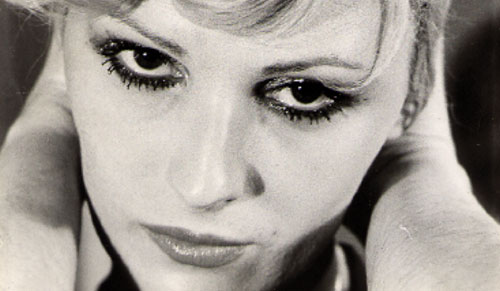[This is the second in a series of dispatches relating to the New Directors/New Films series, running between March 24, 2010 and April 4, 2010 at MOMA and the Film Society of Lincoln Center.]

“You must always be yourself, no matter what the price.” — Candy Darling’s diary
Candy Darling — born James L. Slattery — was arguably the most intriguing of Andy Warhol’s fearless thespians. She was not only talented enough to dupe The New York Times‘s critical acumen (“this is the first impersonation of a female impersonator I have ever seen,” read one of the Gray Lady’s reviews), but she inspired Lou Reed to write one of his most famous songs and Tennessee William wrote Small Craft Warnings for her. But was Darling, who died of lymphoma at the needlessly young age of 29, truly herself even while charming the thriving New York art scene of the late 1960s and early 1970s?
A fascinating new documentary, Beautiful Darling, produced by Darling’s friend Jeremiah Newton, doesn’t entirely answer this question. But it does offer an invaluable perspective on what it was like to struggle as a transsexual during that time. If the film errs on the side of cautious hagiography, it atones for this understandable partisanship by highlighting some too easily forgotten truths, pointing to certain liberties and folkways now taken for granted. Female impersonation was a dangerous criminal charge during the time, considered an indecent aberration that was doggedly upheld by the police. Drag queens were forced to carry their sartorial bundles during the day and change clandestinely within buildings. The empowering compromise one could get away with, as identified in the film by Agosto Machado, was “a little mascara and a mohair coat.” Triumphant bon vivants would happily shout the name of Gay Street at the intersection of Christopher. New York, now a less tolerant playground for the rich, was then considered, as Fran Lebowitz suggests in the film, “a place for people who couldn’t fit in. People who actually did something that nobody was interested in.” Speed was heavily ingested. Bohos and misfits were often forced to find their meals at parties thrown by the affluently curious, taking home the remains for tomorrow’s lunch.
Darling thrived within this harsh yet permissive climate, attracting a league of potential dates and hanging out in the permissive backroom of Max’s Kansas City, where the squares couldn’t make it past the velvet rope. But the seeds for this twentysomething transformation were sown in Massapequa Park, Long Island, where a young Darling waded through movie magazines, spent an entire day staring at a Kim Novak photo, and endured a nearly soul-crushing wave of isolation. In Beautiful Darling, the diary entries — the words solipsistic but uncompromising — are read by Chloe Sevigny. One harrowing photo that accompanies these narrations, showing a pre-Darling Slattery with a painful look on his face, his arm gripped by his mother, is more than enough to convey a sad backstory. Thankfully, additional details are filled in beyond these primary sources. Aside from the film’s many interviews, which include numerous Factory acolytes and Warhol’s decidedly unnerved former secretary, by Newton’s many interviews in the mid-1970s, conducted after Darling’s death. We learn that Darling’s mother married another man who was anti-gay. An anonymous Long Island acquaintance declares her hatred for Darling, once she saw her adopting her truer identity.
But was Darling’s identity genuine? Or some compromise? The film delicately tiptoes over these questions, but it does point to Warhol’s eventual abandonment of Darling so that he can cash in on the forthcoming yuppie-fueled lucre. He later proved, as one former associate puts it, more interested in selling ads for Interview. Darling declares in her diary, “I’m not a genuine woman. But I’m not interested in genuineness.” Yet Darling was driven to Warhol as a genuine benefactor. The Factory’s obsessiveness with pop culture served as a vital surrogate for Hollywood, even if the remunerative pickings were slim (merely $25 to appear in a Warhol scene). There seemed no other place for Darling to thrive. But she was dogged enough to make this difficult situation work, even after being shunned by Warhol. She proudly boasted that she collected no money and would crash on friends’ couches, sleeping until six or seven at night.
“I must conquer New York or be conquered,” wrote Darling in her diaries. It was a daring ultimatum that seems unthinkable for most artists of her type today. After seeing this film, I wondered what Darling would have made of herself had she lived longer. Would she have been co-opted by marketing forces during the Reagan years? Would she have been shunned further? Darling claimed that she wanted to be loved, but one wonders whether the pop cultural construct and the tolerance would have expired. Beautiful Darling works so well because of the way it quietly reveals the unforgiving characters within alternative culture. If you write off or forget the misunderstood, or you’re too busy designing soup cans or collecting corporate revenue, are you really all that different from a narrow-minded stockbroker?